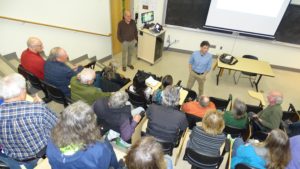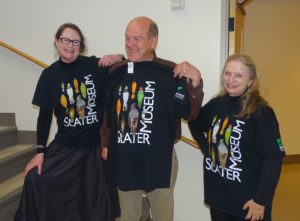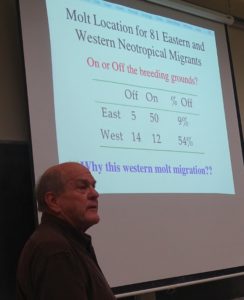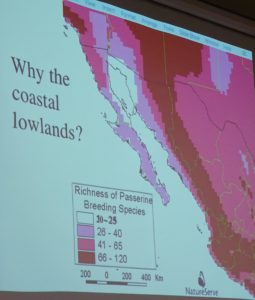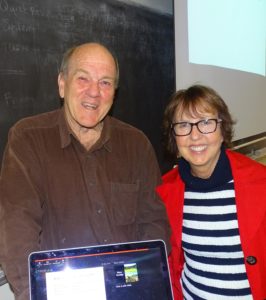ABC teamed with Tahoma Audubon and the Slater Museum at UPS to bring back one of our favorite speakers from 2015, Sievert Rohwer of UW/Burke Museum, to explain molt migration to us. He decided we understood his previous talk on types of molt, so instead of reviewing, he plunged directly into molt migration. It was a privilege to have him return to see us, as we learned a lot last time and felt we had made a friend.
Peter Wimberger, director of the Slater Museum, introduced his previous professor to the crowd and presented him with a Slater Museum T-shirt!
Professor Rohwer got right into it with evidence that previous researchers had gotten it wrong, assuming that since they knew the pattern of molt migration in eastern species — that western species would have a similar pattern. Wrong! Turns out Sievert’s team found Lucy’s Warbler molts on its wintering grounds in Mexico and not in the U.S. before migration, and they were just the first inkling of a larger pattern. The Adolfo study turned over the old paradigm by studying specimens from every collection they could get, showing western molting birds to be much more likely in Mexico than the U.S.
And these passerines weren’t just molting in Mexico, but in the coastal lowlands. Some older studies had been skewed by the fact that collectors liked the mountains, but birds didn’t. There was a true difference from eastern U.S. neotropical migrants who molted before flying south. Our western birds followed the Mexican monsoons. Sievert vividly recounted how rich in birds an area would be, then his team would go elsewhere, only to return 2 weeks later and find the area devoid of birds after the swarms stripped monsoon growth bare. Many of the birds had the ability to put on huge stores of fat overnight that allowed them to lead this kind of life.
Painted Buntings’ migration patterns showed molting grounds and wintering grounds that didn’t match up, as shown by new monthly population maps. These are more up-slope movements, and again the maps show this trend when overlaid by elevation and moisture. (See https://peerj.com/articles/1871/#supp-1)
A disturbing piece of research has revealed that passerine females who molt down south have a rougher time of it than the males, arriving later for a shorter molt cycle, finding the males have eaten all the best food, and then being stuck having to grow a set of primaries simultaneously instead of taking their time.
Sievert spiced up his slide show with giant grasshoppers being eaten by beetles and other grasshoppers, as well as tarantulas and instructions on how to catch them!
Species discussed included Lucy’s Warbler, Lazuli Bunting, Indigo Bunting, Bullock’s Oriole, and then when Sievert was trying to tie up his talk, he started in on Yellow-billed Cuckoos. Apparently they used to breed all over the western U.S., but they really haven’t decreased in the way we think up here in Washington. Instead, cuckoos found lots of food closer to where they molted and quit coming north. Unless you’re talking strictly about Washington State, these birds are not endangered at all, but very common! We need to know more about this, Sievert!
Sievert’s last slide posed the question, “How did collections fail us?” This turned out to be a major theme for this research. Numbers of specimens and times of collection in the past bore little correlation to where the most birds were and what they were doing. Thanks to Sievert Rohwer, that is changing.

